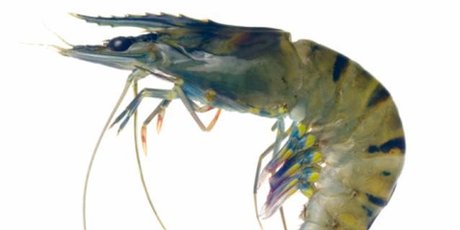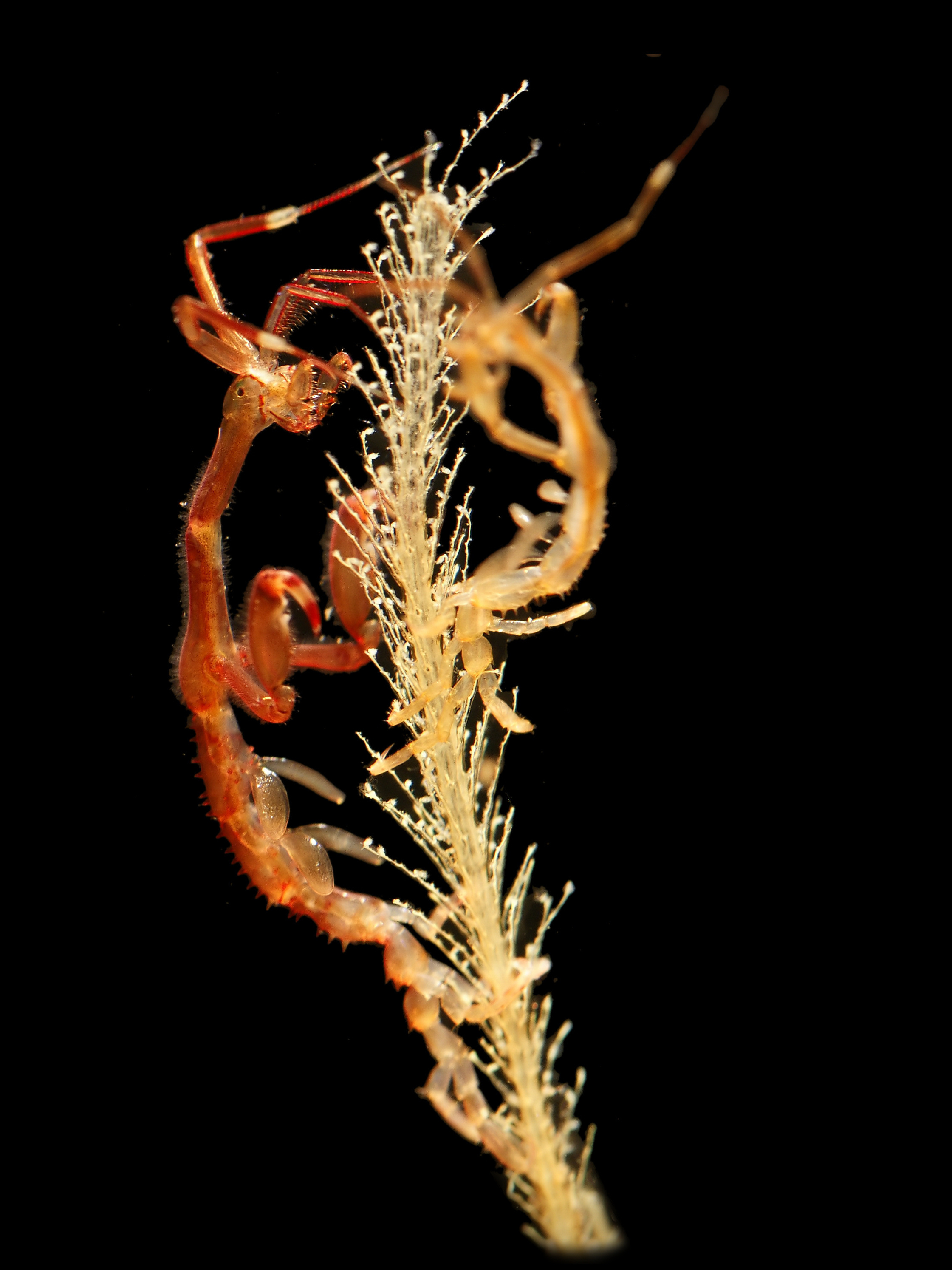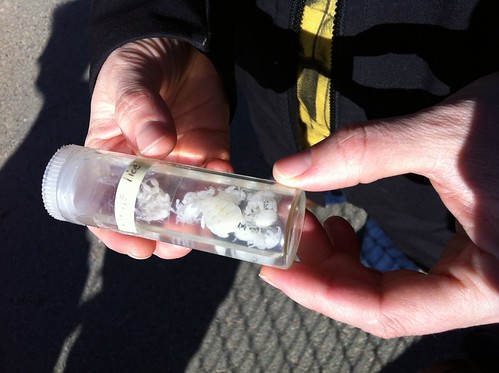Sunday, February 19, 2012
Sunday Spinlessness - Amphipods are not prawns (and it matters)
A couple of weeks a go the internet was abuzz with the discovery of giant deep-sea amphipods off the coast of New Zealand. Invertebrates, form New Zealand featuring in a story that once again highlights how little we know about life on earth - surely, this should be a story that brings me nothing but joy?
Sadly, the New Zealand Herald managed to take just a tiny bit of gloss of the story. They choose to call the creatures "prawns" and illustrated their story with this picture...

...which when clicked to achieve a larger view gives us this:




Caprella mutica. Photo is CC-BY-SA 3.0 from Hans Willewart

All the trees here were made with iTOL, this first is their main tree drawn unrooted. The animal and Malacostraca trees are the NCBI taxonomy drawn to phylum and genus level respectively
Sadly, the New Zealand Herald managed to take just a tiny bit of gloss of the story. They choose to call the creatures "prawns" and illustrated their story with this picture...


Quite some transformation. Needless to say, amphipods are not prawns and the creature in the larger photograph is only distantly related to the mega-amphipod in the smaller one.
Am I being ridiculously pedantic to care about this error? Is my life really so easy that I have time to worry about taxonomic and nomenclatural details associated with reports in the Herald? In fact, there's more to this error than the name. The Herald's conflation of these two distantly related groups highlights the way we fail to comprehend the true diversity of life on earth. So here's my attemp to show what you miss when you call an amphipod a prawn.

Forget animals and plants as the "two kingdoms" of life. For most of the history of life every creature on earth was a single cell. Even today, most of the lineages that extend out from the biology's big bang are made entirely of singled-celled organisms. Because this tree is based on those species that scientists have sequenced the genomes of, it drastically over-represents animals, but even here all animals are represented by the little twig that descending from the black-labeled node.
Biodiversity is more or less fractal, if we zoom in on that node and look at the phylogeny of animals we get another tree with branches:

As I've said before, it's very difficult to resolve the relationships among the different lineages of animals. No matter how the branches relate to each other, it's clear there are a lot of different ways to be an animal, and that I'm never going to run out of subjects to write about for these Sunday posts. All the lions, tigers, bears, elephants, fish, fowl, lizards and frogs that make their way around the world with the aid of a backbone are part of the branch labeled Chordates above. The rest are invertebrates, and so fair game for me. But I'm meant to to be talking about amphipods, so let's skip a couple of steps and move into the arthropods (jointed-limbed creatures including insects) then down further into crustaceans and in particular the class Malacostraca - a group that includes crabs, lobsters, shrimps, wood lice and indeed amphipods and prawns:
Am I being ridiculously pedantic to care about this error? Is my life really so easy that I have time to worry about taxonomic and nomenclatural details associated with reports in the Herald? In fact, there's more to this error than the name. The Herald's conflation of these two distantly related groups highlights the way we fail to comprehend the true diversity of life on earth. So here's my attemp to show what you miss when you call an amphipod a prawn.
The scale of biodiversity
Every cell in my body is the result of an unbroken-chain of cell division that stretches back 3.8 billion years. I find that an absolutely staggering fact, but I shouldn't feel too special. Really, I 'm just like every creature on earth - riding on the edge of one of the lineages that extends out from biology's big bang at the origin of life. Plenty of people have tried to illustrate the history of life, here's one more look, based on DNA sequences from living organisms:
Forget animals and plants as the "two kingdoms" of life. For most of the history of life every creature on earth was a single cell. Even today, most of the lineages that extend out from the biology's big bang are made entirely of singled-celled organisms. Because this tree is based on those species that scientists have sequenced the genomes of, it drastically over-represents animals, but even here all animals are represented by the little twig that descending from the black-labeled node.
Biodiversity is more or less fractal, if we zoom in on that node and look at the phylogeny of animals we get another tree with branches:

As I've said before, it's very difficult to resolve the relationships among the different lineages of animals. No matter how the branches relate to each other, it's clear there are a lot of different ways to be an animal, and that I'm never going to run out of subjects to write about for these Sunday posts. All the lions, tigers, bears, elephants, fish, fowl, lizards and frogs that make their way around the world with the aid of a backbone are part of the branch labeled Chordates above. The rest are invertebrates, and so fair game for me. But I'm meant to to be talking about amphipods, so let's skip a couple of steps and move into the arthropods (jointed-limbed creatures including insects) then down further into crustaceans and in particular the class Malacostraca - a group that includes crabs, lobsters, shrimps, wood lice and indeed amphipods and prawns:

Now we can start to how broad a brush you'd need to paint amphipods into the same group as prawns. In fact, the lineages that went on to give rise to modern amphipods, on the one hand, and prawns on the other parted ways about 130 million years ago. That's much more ancient than the divide between, say, mice and elephants. What's more, the amphipods are a much more diverse and interesting group than the prawns into which they were lumped.
So what is an amphipod?
I'm willing to admit that "amphipod" is not a term with which many people are familiar, and that the Herald had to find some way of explaining what a normal amphipod might look like. The only amphipod that most people are likely to be familiar with is the "sand hopper". The little crustaceans that bounce away from beach-cast seaweeds when you pick them up are examples of typical amphipods. Most gardens in New Zealand will have species closely related to the sand hoppers living under logs (this one was actually living under a flower pot):

That's the basic amphipod body plan - a relatively soft exterior divided into 13 sections, two large antennae , two compound eyes and lots and lots of legs divided into different sets for different jobs. By and large amphipods are scavengers, eating decaying matter where ever they get their limbs om it. The land-dwelling amphipods are the only ones you are likely to have seen up close, but most species live in the sea.
Most marine amphipods look more or less like their land-lubber relatives. The super giants that showed up in the Kermadek Trench are presumably from the genus Alicella, which is related to, and more less a scaled-up version of, your typical scavenging amphipod. Other groups of amphipods have remained small, but radically reworked their ancestral body plan. The most striking example of such a reimagining are the elongated caprellids or "skeleton shrimp":
Most marine amphipods look more or less like their land-lubber relatives. The super giants that showed up in the Kermadek Trench are presumably from the genus Alicella, which is related to, and more less a scaled-up version of, your typical scavenging amphipod. Other groups of amphipods have remained small, but radically reworked their ancestral body plan. The most striking example of such a reimagining are the elongated caprellids or "skeleton shrimp":

Caprella mutica. Photo is CC-BY-SA 3.0 from Hans Willewart
There is another radically different amphipod that I'm sure you've seen photos of, even though you don't know it. Here's a colony of them:

The bumps around the heads of right whales (called callosities) are part of the whale's body, but the white colouration results from the thousands of cyamid amphipods which live on these bumps. Unlike barnacles, which also attach themselves to whales, cyamids don't have a free-swimming larval stage, so they are only passed on from one whale to another through contact. Researchers have even used the genetic relationships between cyamids to learn about relationships among whale populations
Cyamids are commonly called "whale lice", and indeed their flattened bodies are similar to those of their distant insect cousins:
Cyamids are commonly called "whale lice", and indeed their flattened bodies are similar to those of their distant insect cousins:
.
By contrast with the diversity found within the amphipoda, prawns are pretty limited morphologically. I realise the Herald's headline synonymising the first into the second reflected a general lack of understanding about the sorts of creatures that fill our biosphere, rather than a particular oversight on their behalf. But when the true picture is so much more interesting than the lazy shorthand they used, I think it's worth pointing out the error.
All the trees here were made with iTOL, this first is their main tree drawn unrooted. The animal and Malacostraca trees are the NCBI taxonomy drawn to phylum and genus level respectively
Labels: amphipoda, crustacean, sci-blogs, sunday spinelessness, taxonomy



